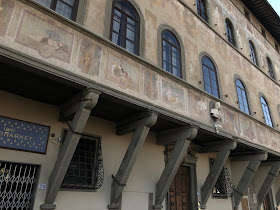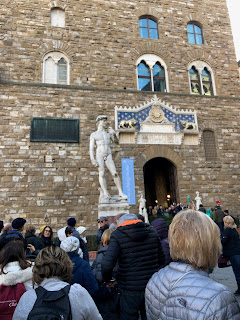Sunday, February 17, 2019
Our first stop on our walking tour of Florence was the National Central Library of Florence, founded in 1714 when scholar Antonio Magliabechi bequeathed his entire collection of approximately 30,000 volumes to the city of Florence. Since 1870, the library has collected copies of all Italian publications. The flood of the Arno in 1966 damaged nearly one-third of the library's collection. It is a public library open to anyone 18 years and older.
Our next stop was the Piazza Santa Croce, the largest piazza in Florence. It is the site of the annual Calcio Storico, a violent game - a mix of soccer, rugby, and wrestling or boxing (depending on who is describing the game). The finals are played in June, but as our guide explained to us, that afternoon the Match of the Siege would be played at 4 on the piazza. We would be on our way back to Rome by then. Later that afternoon, we would see the teams and other representatives assembling from the four historic quarters of Florence for the corteo storico or "historic procession" before the game.
The current structure of Santa Croce was begun in 1294, replacing an older building of the 1220s. It took almost a century to complete and lacked a facade. The Santa Croce is also referred to as the Temple of the Italian Glories since many notable Italians are buried there, including Michelangelo, Galileo, Machiavelli, Alfieri, and Rossini. We were unable to tour the interior of the church since our visit occurred on Sunday when regular services were being held. The Jewish architect, Matas, designed the facade which was constructed from 1857 to 1863. A blue Star of David is near the top of the roof. Matas wanted to be buried inside Santa Croce, but due to his religion was buried under the porch.
The statue of Dante, erected in 1865 by sculptor Enrico Pazzi to commemorate the poet's 600th birthday, stands next to the church.
Additional views near Santa Croce
Commemorative plaque for Michelangelo's birthplace
Gorgeous Florentine blue sky!
Palazzo Vecchio
The Palazzo Vecchio was completed in 1322 and was originally known as the Palazzo Popolo (Palace of the People), but later renamed to Palazzo Vecchio (Old Palace). From the 14th century on, Florentines gathered at the square for important political occasions and rulers often addressed the citizens here. Today the former palace is the Florence Town Hall. Piazza della Signoria
This L-shaped square in front of the Palazzo Vecchio is Florence's most important square. It has been the cultural, political, and social heart of the city since the 14th century and remains a significant gathering place for Florentines and tourists.
Loggia de Lanzi is an open air sculpture gallery built between 1376 and 1382 to house the assemblies of the people and hold public ceremonies.
Perseus with the Head of Medusa
by Benvenuto Cellini (1554)
The Rape of the Sabine Women by Giambologna, completed in 1583
The most famous bridge in Florence, Ponte Vecchio, was built across the Arno in 1220. The structure seen today dates from 1345, a replacement for the earlier bridge which was destroyed by a flood.
The houses across the bridge were initially used as workshops and a diverse array of shopkeepers did business here. In 1593, Duke Ferdinand I decided to replace them with goldsmiths and jewelers because the shops produced too much garbage and foul smells.
Views of the River Arno from Ponte Vecchio
Piazzo del Duomo
The baptistery was first constructed in the 6th century and completely rebuilt as a Romanesque octagonal structure beginning in 1059. In 1128, it was consecrated as the baptistery of Florence and is the oldest religious moment in Florence.
The Duomo (cathedral) of Florence was originally designed by
Arnolfo
di Cambio in 1294. Work began in 1296, but would take more than 140
years to complete. The dome was built from 1420 to 1436. The cathedral
facade however was not complete until 1887.


The
freestanding bell tower, or campanile, is the work of Giotti who was
appointed chief architect of the cathedral some years after Arnolfo's
death.

The Accademia
This
art school and museum houses the original of Michelangelo's David. From
the 18th century on, this is where Florentine artists were trained.
Nothing prepared me for seeing the majesty of this David. Almost 17 feet
tall, the statue was carved from one block of marble from the Carrara
marble quarries.
Then
it was time for lunch in the Mercato Centrale, a two-story glass and
stone building erected in 1874. Every possible kind of produce from
Tuscany is available here.
After lunch we had a bit of time for
shopping. Our guide highly recommended this establishment for hot chocolate. We were not disappointed!


There's something lovely about encountering street musicians playing classical music on a street in Florence. I recorded their impromptu concert. Listening to it transports me to Italy and the delightful memories of our trip.
We followed the steady drum beats to discover the assembling of men in costume (see previous page) representing the four neighborhoods of Florence. They would be part of a historic procession through the streets before the Match of the Siege game that was scheduled for that afternoon at Santa Croce.
Then it was time for the long walk back to our hotel and our bus ride back to Rome. We enjoyed a farewell dinner with our group before heading to bed for a few hours of sleep.
This was the view that greeted us as we arrived at the almost deserted Rome airport at 3:30 am on Monday morning.
Arriverderci, Italy!
You captured our hearts and we hope to return someday.































Amazing photos and so much history and information here! Thank you for sharing! I would love to get to Florence someday.
ReplyDelete